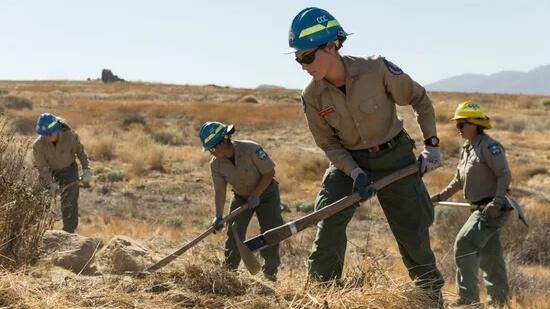Let’s chat tools! When you first google trail building tools, you’ll receive many suggestions. There is a wide variety of tools for different jobs available from surveying to constructing to maintaining. So how do you choose the right kind of tool before heading out into the field?
Local and individual preference often dictate which tools are chosen, but many will perform better for different tasks. Before setting out into the field though, every trail worker needs to not only learn how to choose the correct tool for the job, but how to use it safely and effectively, caring for the tool, and how to store the tools.
Tool Safety
Before starting on any project, whether as a volunteer or professional crewmember, the site supervisor should cover all tool safety tips with everyone who will be in the field.
Watch your surroundings. Both for people and natural hazards. When you are in the field, you want to be aware of any people that may enter your zone. This includes both other crewmembers and trail users, especially on trails that are in use. When you see someone coming, stop working and notify other crew around you while you wait until the person passes. When you are swinging your tool, you want to make sure that there are at least four tool lengths between you and another person on the crew. This makes sure that you won’t hit someone else, or their tool when swinging.
You also have to keep an eye out for natural hazards, both overhead and on the side. A hazard is anything that could interfere with the complete swing of your tool. Keep your tool in front of you at all times. You should never need to swing the tool over your head.
Watch your footing. You’ll want to clear any debris from your footing area like limbs, sticks, and loose rocks. Start with a firm and balanced stance before starting. Especially with striking tools, keep your feet well spaced from the target area.
Get a grip! You want to make sure you have a good grip before performing any work. Especially with striking tools, wet or muddy gloves could cause a tool to slip mid swing.
Dress the part. Everyone has their favorite clothes to wear when working on the trail. Long pants and work boots keep you protected from flying branches, and many choose to wear a long sleeve shirt. Hard hats, work gloves, and safety glasses should be, depending on tools you are using.
Care for the tool. You want to make sure the tool is sharp and in proper shape. A dull tool can bounce off what you are cutting, making it dangerous. It also will wear you out faster. How do you care for them? We discuss more below.
Pick the right tool. Some jobs are more specialized than others and require more specific tools to get the job done. How do you pick the right tool? Well you’ve come to the right place!
Choosing the Right Tool
There’s a few things to take into consideration when picking out tools for the project such as the length, materials, the weight, who all will be using the tool, how often it will be used, and the packing length of the tool.
Tool Length
For your swinging and chopping tools like hoes, shovels, and rakes, the tools come in a variety of handle sizes. A longer tool has a lot of advantages for not only taller folks, but for folks who will be performing a lot of work with the tool. A longer tool requires less bending over, which helps with back pain at the end of the day. Shorter tools help with precision and working in tighter spaces. If your work requires more precise chopping, a shorter tool will perform better than a longer one.
For saws, a longer blade will cut through larger trees, but will be heavier and bulkier during transport. With a longer handle, you’ll have more reach. You will lose some precision with longer handles though. Teeth size and blade curvature also matters when deciding what saw to pack. Finer teeth are better for making precise cuts, and larger teeth are better for sawing quickly. A curved blade performs better for cuts above the head and below the waist, while straight blades perform better around chest height.
Materials
What materials the tools are made out of is something to take into account. Certain tools, especially those made with fiberglass handles, are more resistant to bugs, chemicals, heat and weathering. If you expect the tools to be left out in a place where bugs and chemicals may eat away wooden tools, a fiberglass handle may be a better option.
Groups
Different tools are better suited towards different groups as well. When deciding what tools you should purchase, take the group who will be using the tool into consideration.
Youth corps and volunteer groups tend to have a higher breaking rate of tools than professional trail building and maintenance crews. Tools that cost less are a better choice for projects like that. They hold up okay still, but are cheaper and easier to replace when they inevitably break a few days into the project. We like to recommend Zac tools for these groups.
Professional trail builders and maintenance crews need a higher caliber of tool. They will be moving a lot of debris very quickly, sometimes for long periods of time. Having a tool that is tough and can withstand a lot of work is important. We recommend tools from brands such as Nupla or Rogue Hoe for these groups.
Some groups require the steel to have a Made in America certification. Brands like Warwood and Council Tool produce their steel in the United States. Rogue recycles agricultural discs from the U.S. and meets this certification as well.
Some restoration groups, corp groups, and trail builders cover many, many miles in the backcountry at a time. These long hitches require them backpacking their gear in, and can see camp moving every night. Finding lightweight and packable tools is key here. We recommend tools from Trail Boss. While at a higher price point, these tools have interchangeable heads and packable handles, which makes them a better choice for moving fast.
If you are buying a tool for yourself, the most important part is finding a tool that you like and that you will like using. This may take some trial and error, but treat yourself, and don’t be afraid to spend a little more money on a tool that you’ll take to every project.
Weight
While weight is certainly something to take into account, some trailbuilders will tell you they rather have a tool that is slightly heavier and does more work per swing than one that is lighter and makes them work harder with more swings.
If you are on a long hitch though and it requires backpacking many miles a day, tools that break down are a popular choice.
Trail Tools: Sawing and Chopping Tools
11 Key Trail Tools for Grubbing and Raking
Trail Tools: Digging and Tamping Tools
8 Most Used Trail Tools for Lifting and Hauling
Trail Tools: Pounding and Hammering Tools
Trail Tools: Survey, Layout, and Measuring Tools
Trail Tools: Miscellaneous Tools
Trail Tools: Sources for Tools & Supplies
Tool Repair and Sharpening
Repair
No matter how well you care for a tool, it eventually will break. Typically you’ll notice the handle breaking well before the metal head on your striking and digging tools. If you notice the handle has cracked or has other significant damage, you’ll want to replace it before using the tool again.
Depending on the tool, replacing the handle can be as simple as unscrewing and replacing, or it may need a full shop, as is common with some fiberglass handles.
Many saws have blades that are easily replaceable when they snap, and having a replacement on hand is great for when that happens.
The metal head can have it’s cutting edge dull down, potentially making it dangerous to use. Examine tools regularly and plan on filing the edges when they are dull. If the head is cracked, replace the tool.
Sharpening
You get the best use from your tool when it is sharp. A 10 to 12 inch flat mill, or a flat, single-cut bastard file is the simplest tool for shaping a bevel or giving a blade an edge. Because of the tooth design, files cut in only the forward direction. Dragging on the backstroke will quickly dull the file. If the file becomes clogged with filings, clean it with a wire brush or a file card.
Safety Tip: Watch for the sharp edges once you’re done! Make sure your file has a knuckle guard and handle. It’s also a good idea to wear gloves and safety goggles, especially if using a power tool to file.
There’s a lot of information here, so if you are feeling a little lost, reach out to your trail tool experts! And keep in mind that while every tool is designed with a specific use, the right tool is the one that works the best for you.

The Oregon Horse Council is a 501(c)(6) nonprofit that works to strengthen, connect, and represent Oregon’s equine industry.

